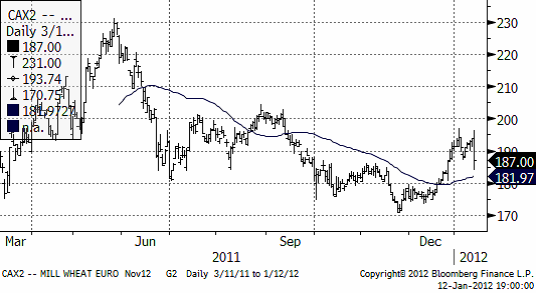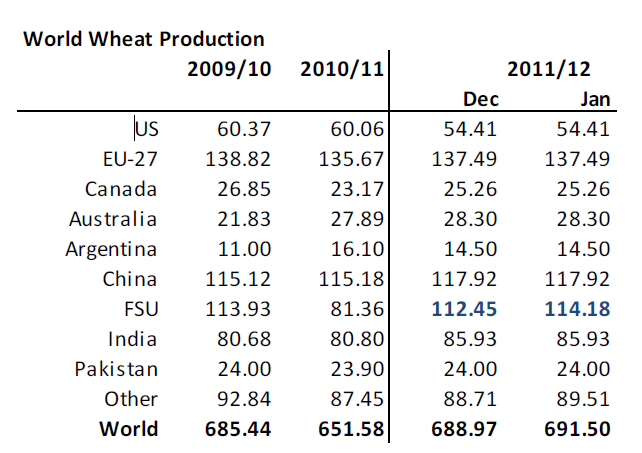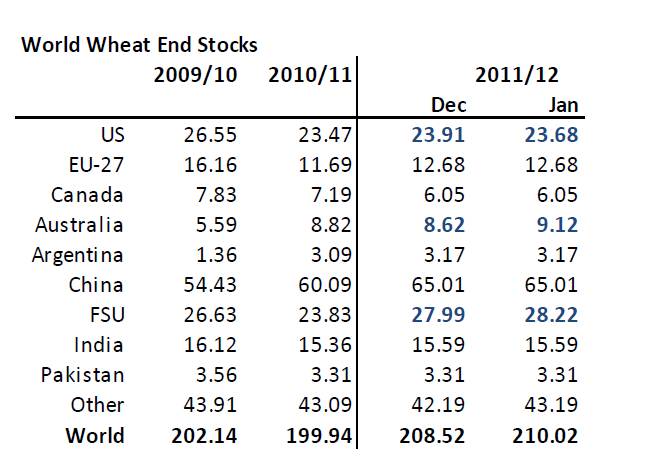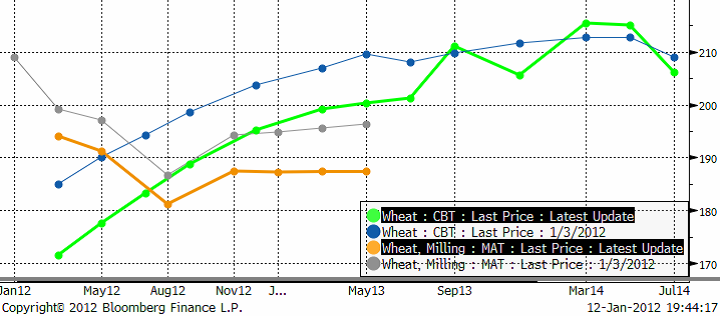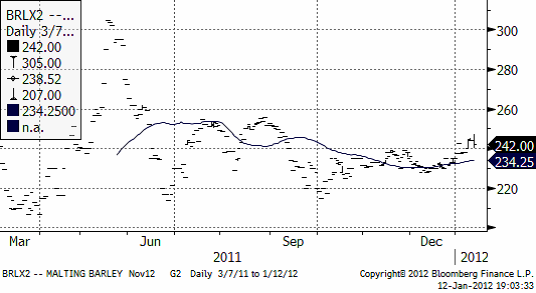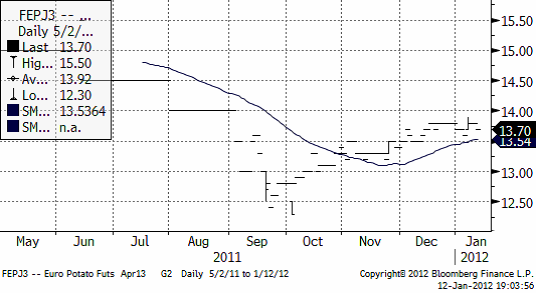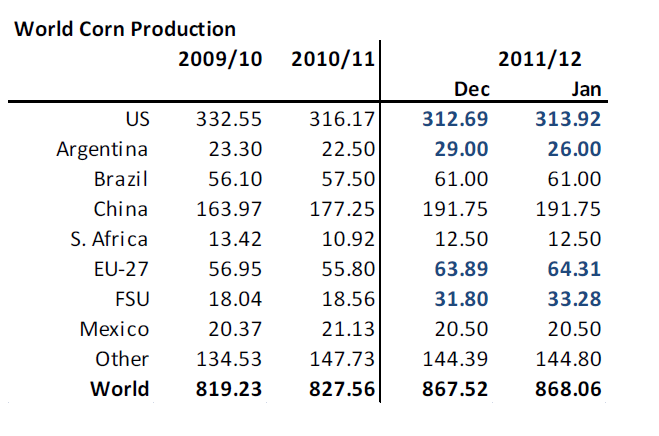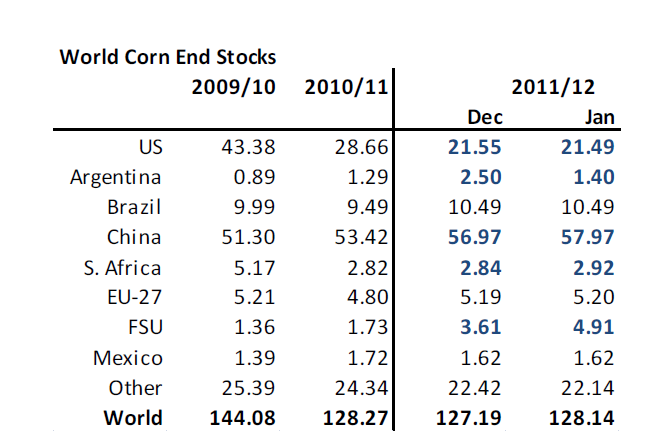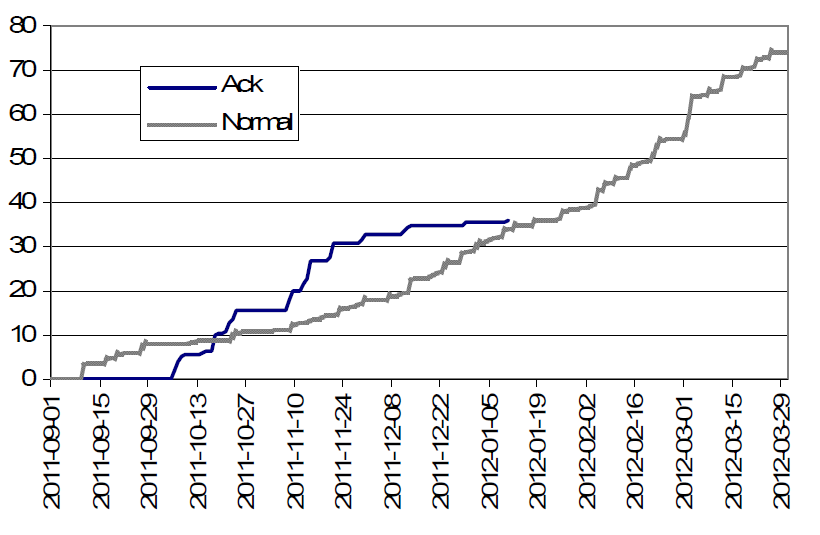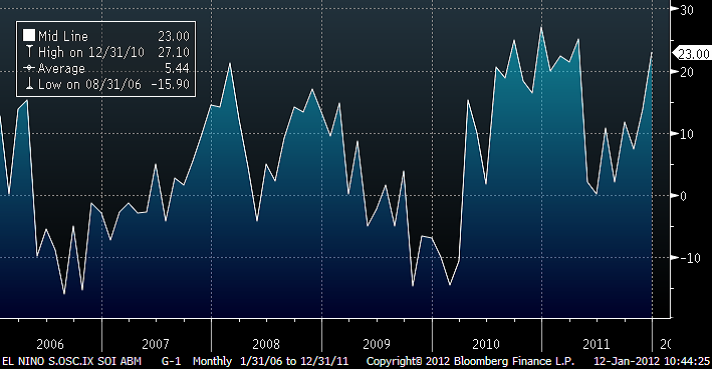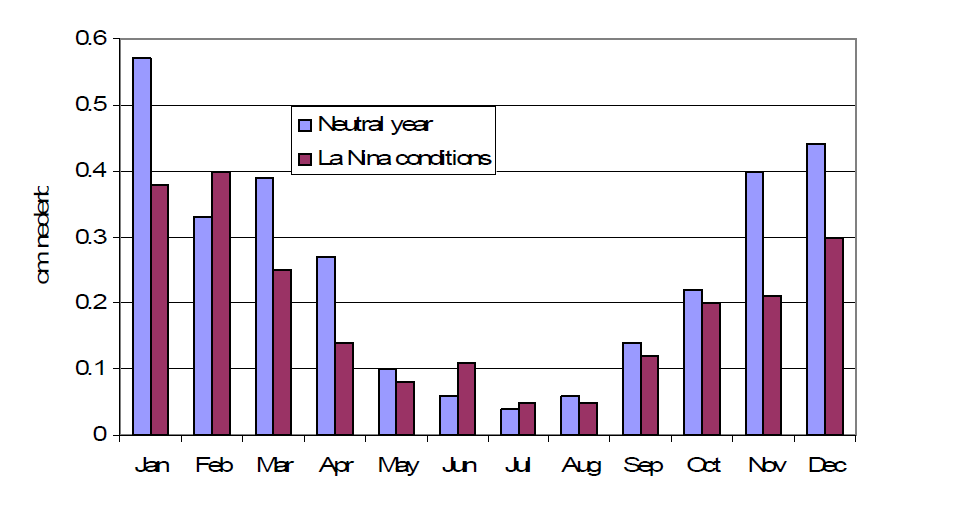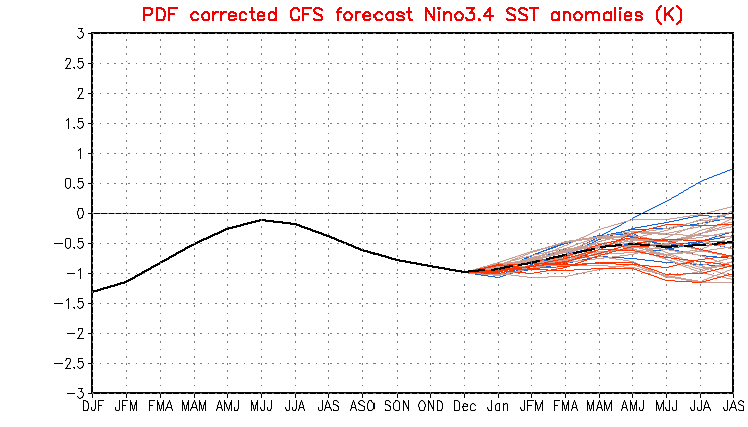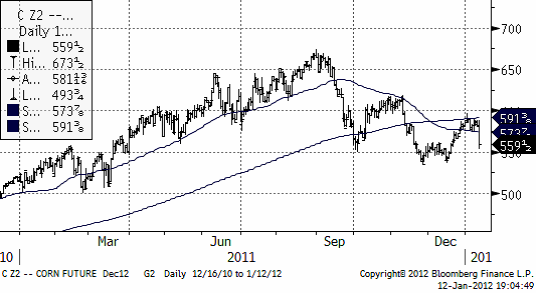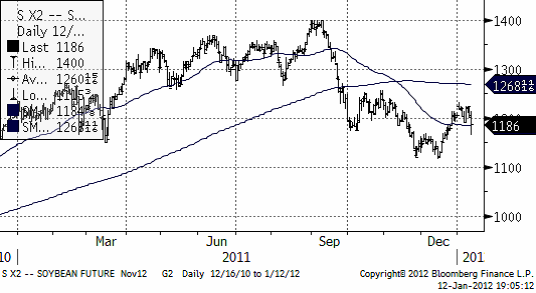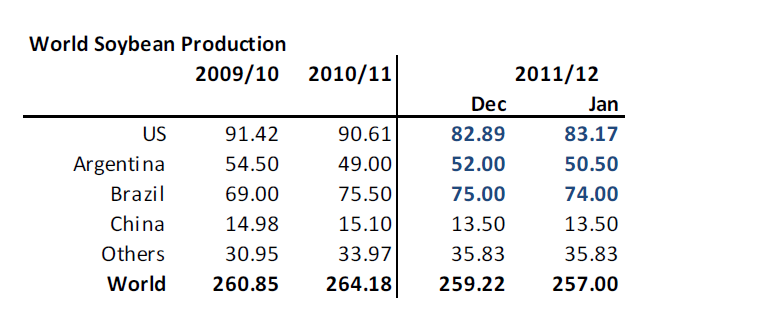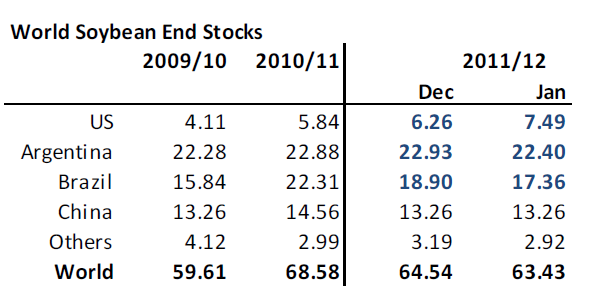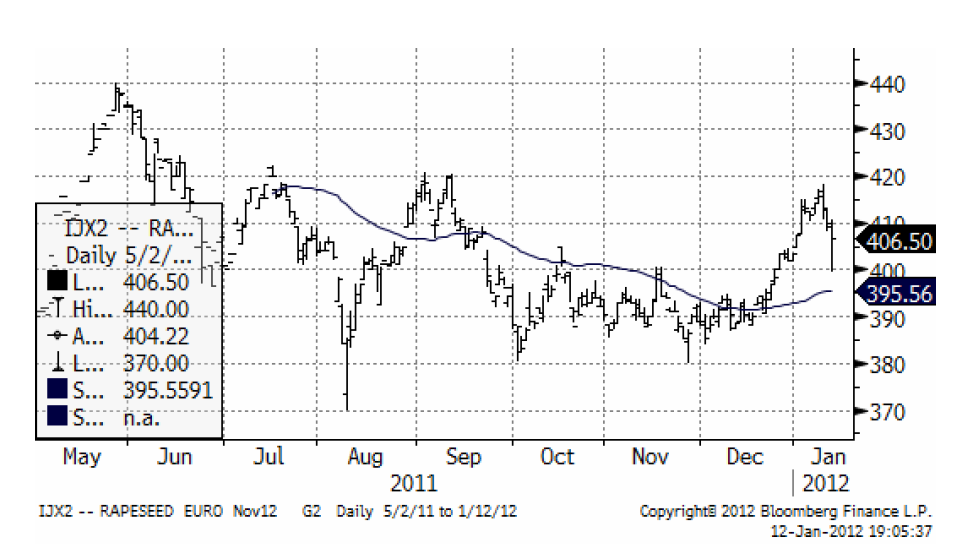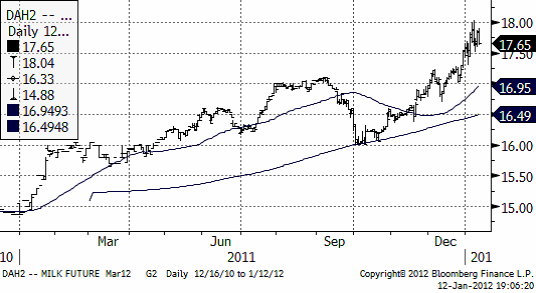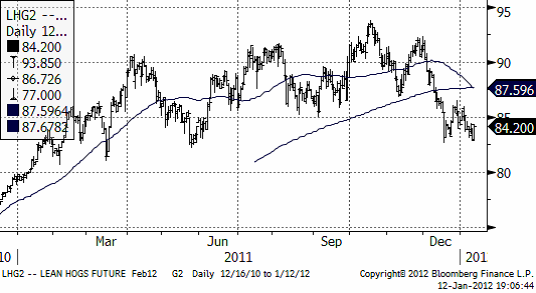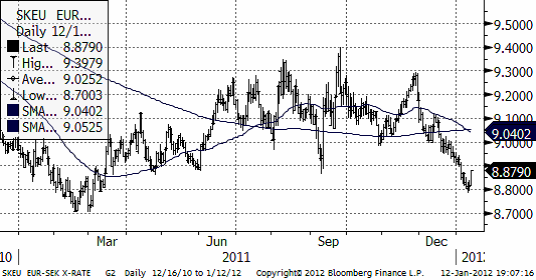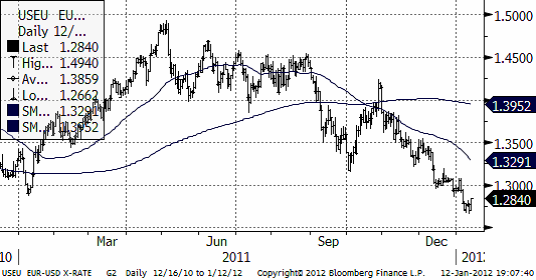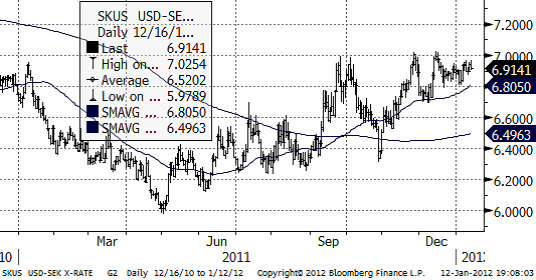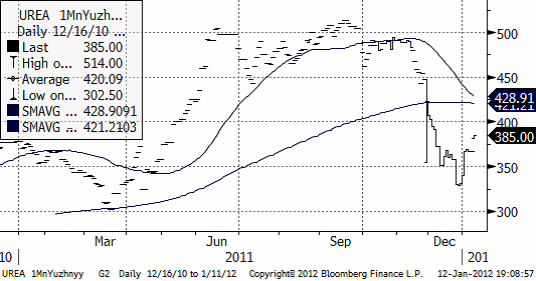Analys
SEB – Jordbruksprodukter, vecka 2
 I detta det första veckobrevet för 2012 om marknaderna för jordbruksprodukter. Årets första dagar har varit avvaktande och det är först i och med gårdagens WASDE-rapport från USDA och den kvartalsvisa sådd- och lagerstatistiken, som kalenderåret börjar. Som vanligt så här års är det på södra halvklotet det sker saker.
I detta det första veckobrevet för 2012 om marknaderna för jordbruksprodukter. Årets första dagar har varit avvaktande och det är först i och med gårdagens WASDE-rapport från USDA och den kvartalsvisa sådd- och lagerstatistiken, som kalenderåret börjar. Som vanligt så här års är det på södra halvklotet det sker saker.
La Niña har återkommit och drivit upp spannmålspriserna, men ensembleprognosen från NOAA indikerar att La Niña har nått sin kulmen. Väderleksrapporter t ex på brasilianska tv-kanalen Canal Rural visar ganska mycket regn i torkdrabbade södra Brasilien (och norra Argentina).
Ryssland har lyckats hämta sig med besked från torkkatastrofen år 2010. Vi tror året kommer att innebära sjunkande priser på spannmål. För veteodlare erbjuder också Chicago-terminerna ett attraktivt contango för den som vill sälja och prissäkra årets skörd.
Vete
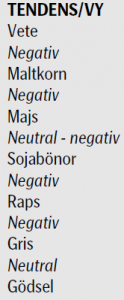 För att summera 2011 års prisrörelser på vete, kan vi konstatera att kvarnvetet på Matif noterar en nedgång sedan förra årets början med 50,00 eur/t (minus 19.8%). Det högsta stängningspriset under året på 278.50 eur/t noterades i februari och det lägsta stängningspriset under året var 178.50 eur/t i slutet av november.
För att summera 2011 års prisrörelser på vete, kan vi konstatera att kvarnvetet på Matif noterar en nedgång sedan förra årets början med 50,00 eur/t (minus 19.8%). Det högsta stängningspriset under året på 278.50 eur/t noterades i februari och det lägsta stängningspriset under året var 178.50 eur/t i slutet av november.
Fodervete på LIFFE London presterade ännu något sämre med en nedgång på 46.75 GBP/t (minus 23.5%) sedan förra årets början. Det högsta stängningspriset under 2011 blev 217.50 GBP/t och noterades i april och det lägsta stängningspriset låg på 141.00 GBP/t och noterades i december.
Det amerikanska vetet på CBOT har klarat sig något bättre i jämförelse med det europeiska och ”bara” fallit med 141 1/2 cent (-18%) sedan förra årets början. Det högsta stängningspriset på 886 cent noterades i februari och det lägsta stängningspriset på 573 ½ cent noterades i mitten på december.
2011 var också året då rapporter om rekordskördar duggade tätt, bl a från Australien, Kazakstan, Indien och Kina. I Indien estimerar man nu en ännu högre skörd för 2012 än förra årets rekordskörd på 85.93 miljoner ton till följd av ökad areal och fördelaktigt väder. Skörden där börjar om 2-3 månader.
Sedan förra veckobrevet i mitten av december har priset på vete vänt uppåt. Detta är orsakat av en ökande oro för torka i Sydamerika (framförallt Argentina), som har drivit upp priserna på majs och sojabönor och gett support till vetet men också på grund av torka i delar av USA och Östeuropa. Framförallt Ukraina har drabbats hårt av detta och där räknar man med en betydligt lägre skörd i år.
Ur ett politiskt perspektiv säger regeringen i Ukraina att de trots detta inte kan se någon anledning till höjda brödpriser under 2012, vilket troligtvis hänger samman med att det är parlamentsval i oktober. En svagare euro har också gjort det europeiska vetet mer konkurrenskraftigt på exportfronten, det senaste beviset på det var i fredags då Frankrike knep nya marknadsandelar då Egyptens GASC köpte 240 000 ton vete varav hälften franskt (andra halvan fördelades mellan Ukraina och Ryssland / Kazakstan).
Enligt Rysslands jordbruksminister var förra året en milstolpe inom den ryska jordbrukssektorn då man nu har uppfyllt målet att vara självförsörjande på spannmål, socker, raps, potatis och fjäderfäproduktion. De räknar också med att inom loppet av 2-3 år ska även den ryska produktionen av fläsk att uppfylla det kravet. Danmark lär påverkas negativt, då en stor del av Danmarks produktion gått till ryska konsumenter.
Ryssland lyckades också övervinna följderna av det tidigare årets torka och kraftigt öka produktionen av sina viktigaste grödor. Spannmålsskörden uppgick till 92 miljoner ton, en ökning med över 50% från året innan. Fram till årsskiftet har Ryssland exporterat ca 17 miljoner ton spannmål, varav ca 14 miljoner ton vete.
Prognosen för 2011/12 är en export på 25 miljoner ton, men takten brukar avta något under denna årstid bla på grund av logistikproblem.
Men även om Ryssland drar i bromsen för export vid 25 miljoner ton så finns det andra som mer än gärna tar vid, Kazakstan t.ex.
Nedan ser vi kursdiagrammet för novemberkontraktet på Matif.
Det var inte bara WASDE-rapporten som släpptes idag, utan också kvartalsvisa lager i USA och höstevetesådden i USA. Lagerstatistiken överskuggades av WASDE-statistiken, men höstsådden hade stor effekt. Nedan ser vi sådden i miljoner acres. Totalt sett har arealen ökat med 2.5%. White wheat minskar, medan SRWW (Chicagosorten) ökar med 7.7% och Kansas City-sorten HRWW ökar med 2.2%.
Plantingsrapporten i sig var klart negativ för prisutvecklingen, men WASDE-statistiken som vi ska gå vidare till nu, var också negativ. Nedan ser vi först tabellen för global produktion.
Vi ser att global produktion justerades upp med 2.5 mt. Det är främst i FSU (Kazakstan) med 1.5 mt och Brasilien med 0.8 mt som produktionen blivit högre än vad man trodde i december. Global konsumtion ökade också, med 1.2 mt, och en stor del av det sker i just Kazakstan, vilket förklarar varför utgående lager i FSU inte förändras med bara +0.23 mt.
Australiens export väntas bli något lägre, vilket innebär att lagren ökar. Totalt sett visade WASDE högre utgående lager, dvs mer av samma trend som i höstas.
Nedan ser vi terminskurvan för Chicagovete och Matif nu och för en vecka sedan. De ”feta” kurvorna är de aktuella. De ”smala” är förra veckans. Det fortsätter att vara ”backwardation” på Matif, dvs terminspriserna för längre löptid är lägre än för korta. I USA är det däremot ”contango”, högre terminspriser ju längre ut i tiden man kommer. Det är lagringskostnaden som orsakar contangot. Notera att priserna är mycket lägre nu (efter WASDE) än de var för 7 dagar sedan.
Vi fortsätter att tro på en nedgång i vetepriset under året.
Maltkorn
Maltkornsmarknaden har behållit sin styrka relativt andra spannmål med novemberleverans på Matif på 242 euro per ton.
Potatis
Priset på potatis har fortsatt att stiga, för leverans nästa år (av sommarens skörd).
Majs
WASDE justerade upp global produktion något. Argentinas produktion sänktes med 3 mt till 26 mt. Det beror på den svåra torkan där. Däremot lämnade USDA Brasiliens skörd oförändrad på 61 mt. Skörden justerades dock upp i USA, något i EU och framförallt i FSU (fd Sovjetunionen, närmare bestämt i Ukraina).
Exporten sänktes med 1.5 mt för Argentina, men höjdes för USA. Nedan ser vi att globala utgående lager väntas bli 1 mt högre än man trodde i december. Vi noterar att Kina väntas notera högre utgående lager.
3 mt lägre skörd i Argentina orsakades av torkan där. Med WASDE för januari nu bakom oss – och ett motsvarande stort prisfall, är det vädret i Sydamerika som står i fokus. Torka i Argentina och södra Brasilien talas mycket om, men vad handlar det om, egentligen?
Majs odlas i norra delarna av Argentina. Ca 20% av skörden sker i delstaten Buenos Aires och något mindre i Cordoba, något åt nordöst från BA. De rapporter som finns säger att torkan är svårast just i delstaten Buenos Aires. Nederbördsstatistik finns för flygplatser och för att inte få ett utpräglat kustklimat som för Buenos Aires flygplats, när det mesta odlas betydligt längre in i delstaten, så kan man istället studera nederbörden vid staden Cordobas flygplats. Förhoppningsvis är detta något mer representativt för hur det regnar över majsfälten.
Nedan ser vi ackumulerad nederbörd från odlingsårets början, som för den här delen av Argentina börjar ungefär den första september. Skörden avslutas normalt i mars. Vi ser att nederbörden har avtagit och det har varit ganska ”torrt” i december och i de första tio dagarna i januari. Det finns alltså en befogad oro för nederbörden framöver i Argentina och kanske södra Brasilien. I Brasilien i stort är det just nu enorma skyfall och i södra Brasilien är det värst. I närheten av Santa Catarina har en hel by spolats bort. Nedan, alltså, ackumulerad nederbörd sedan första september med normalnederbörd inriktad, för Cordoba:
Igår, onsdag, sade Brasiliens jordbruksminister Afonso Florence, till journalister i Brasilia att Brasiliens torka kan leda till ”stora” skördebortfall i Brasiliens södra delar – och tillade att detta ”uppenbarligen” kommer att ha en effekt på inflationen.
Jag tror att man ska tolka detta som att huvudbudskapet egentligen handlar om inflation. Inflation är Brasiliens stora skelett i garderoben. Från att ha varit relativt nedtryckt, har den nu kommit tillbaka och ligger på 6.5%. Arbetslösheten är rekordlåg på 5%, men tillväxten ligger på endast 2%. Landet behöver trycka tillbaka inflationen, men gör man det förlorar man tillväxten. Oron gäller alltså först och främst inflationen och jag tror inte att torkan i södra Brasilien är ett påtagligt hot. Torkan beror på att La Niña kommit tillbaka.
Nedan ser vi ett diagram över the Southern Oscillation Index, som publiceras av the Commonwealth Bureau of Meteorology. Ett värde över +8 indikerar att det råder La Niña-förhållanden.
La Niña orsakar torrt väder i södra Sydamerika och det är troligtvis därför som vi ser att nederbörden i Cordoba avtagit den senaste tiden. Nedan ser vi nederbörden månad för månad för när ENSO-är neutral och när det råder La Niña-förhållanden.
Frågan är hur länge La Niña hänger sig kvar den här gången. Ensembleprognosen från NOAA:s Climate Prediction Center med modellen CSF.v1, publicerad den 9 januari, som vi ser nedan, förutspår att La Niña-förhållanden håller i sig under våren på norra halvklotet (och södra halvklotets höst).
Däremot ser vi att La Niña enligt prognosen når sin ”topp” nu, eller rentav har nått sin topp. Glädjande nog väntas regn just nu i Argentina, men skörden är redan skadad eftersom tidigt sådd majs redan har börjat bilda kolvar och dessa inte fått tillräckligt med näring. I vissa områden har det inte regnat på 40 dagar (så kallad biblisk torka). Sojabönorna har inte drabbats lika hårt och lär kunna repa sig med de regn som nu tycks komma.
Nedan ser vi decemberkontraktet på CBOT, där priset just fallit ner från 600-cent-nivån.
Tekniskt ser det ut som om priset skulle kunna falla ner mot 500 cent, men 550 cent är ett starkt stöd, där det funnits starka köpintressen tidigare.
Sojabönor
Priset på sojabönor föll också kraftigt efter WASDE-rapporten, även om det kom in köpare efter den värsta paniken. Som nämnt ovan har inte den torka som varit påverkat sojaskörden i Argentina så mycket att plantorna inte kan hämta sig om/när det börjar regna. I Brasilien ser det enligt flera källor utmärkt ut.
WASDE-rapporten ser vi nedan:
Skörden justerades ner 1.5 mt i Argentina och 1 mt i Brasilien. USA:s produktion justerades upp på grund av ett högre estimat för odlad areal. Produktionen är summa summarum sänkt med lite drygt 2 mt.
Man gör ingen justering för utgående lager i Kina (antagligen pga brist på information), men man justerar upp utgående lager för USA, huvudsakligen på grund av lägre export. Man justerar ner lagren i Argentina och Brasilien (pga lägre skörd). Utgående lager minskar något mindre än produktionen minskar.
Raps
Skörden av canola i Australien ser ut att nå rekordnivåer. I sin decemberrapport skriver AOF att idealiska väderförhållanden gör att skörden uppgår till 2.95 miljoner ton vilket överstiger det tidigare rekordet från 1999 med över en halv miljon ton. Även värdet på skörden väntas bli rekordhögt.
Faktorer som verkar kursstödjande är den ihållande efterfrågan på biodiesel, framförallt från EU, samt efterfrågan på olja och mjöl från Kina, tillsammans med farhågor över hur det torra vädret i Sydamerika kommer att påverka produktionen av sojabönor.
Rapporter kommer också om rekordskörd i Storbritannien. Avkastningen ökade med 13% till rekordhöga 3.9 ton per hektar och arealen ökade med 10%. Detta ledde till en produktion på 2.8 miljoner ton, en betydande ökning med 24% från 2010. Även Ryssland rapporterar en rekordskörd av raps på 1.1 miljoner ton.
Den fortsatta prisuppgången på råolja, som påverkas av den rådande situationen i Nigeria samt Irans hot om att stänga av Hormuzsundet, har också gett stöd åt rapspriset.
Nedan ser vi priset på novemberterminen på Matif och det stora kursfallet efter WASDE-rapporten klockan 14:30 idag.
Vi har en negativ vy på Matif raps.
Mjölk
Nedan ser vi priset på marskontraktet på flytande mjölk (kontakt avräknat mot USDA:s prisindex). Priset har den senaste månaden fortsatt att stiga.
Gris
Priset på lean hogs har, efter en kort rekyl vid årsskiftet, fortsatt ner, genom 85-cent-nivån. Priset ligger fortfarande kvar i den toppformation som av allt att döma har skapats.
Valutor
EURSEK har helt naturligt noterat lägre priser och var nere på 8.80 kr. Vid jämna siffror hopar sig väntande ordrar, köpordrar i det här fallet när kurserna går nedåt. Idag noterades en kraftig uppgång från den nivån och det får ses mot bakgrund av att det sannolikt fanns mycket köpordar vid 8.80. När Spaniens framgångsrika emission av nya obligationer nådde marknaden handlades euron upp. Uppgångar mot 9 kr ska nog betraktas som säljtillfällen, eftersom t ex Spaniens situation inte är löst bara för att de lyckas låna mer pengar.
EURUSD är i en tydlig negativ trend. Det kom negativ statistik från USA som gjorde att dollarn var en svag valuta idag. Vi ser det ännu tydligare mot SEK i nästa diagram.
USDSEK har en stigande trend och har nått upp till heltalet 7 kr per dollar. Växelkursen har vänt ner därifrån tre gånger tidigare och frågan är nu om kursen ska orka ta sig igenom den här gången. Sker det, så är det en viktig signal från marknaden om ekonomin i USA, men det skulle också kunna ske t ex om Iran blockerar Hormussundet och ökad geopolitisk oro gör att folk vill ”fly” till den ”säkra” dollarn.
Gödsel
Kväve
Nedan ser vi 1 månads terminspris på Urea fob Uyzhnyy. Priset har fallit kraftigt under hösten. En botten noterades vid årsskiftet på lite drygt 325 dollar per ton, men har sedan snabbt rekylerat upp till 385 dollar.
[box]SEB Veckobrev Jordbruksprodukter är producerat av SEB Merchant Banking och publiceras i samarbete och med tillstånd på Råvarumarknaden.se[/box]
Disclaimer
The information in this document has been compiled by SEB Merchant Banking, a division within Skandinaviska Enskilda Banken AB (publ) (“SEB”).
Opinions contained in this report represent the bank’s present opinion only and are subject to change without notice. All information contained in this report has been compiled in good faith from sources believed to be reliable. However, no representation or warranty, expressed or implied, is made with respect to the completeness or accuracy of its contents and the information is not to be relied upon as authoritative. Anyone considering taking actions based upon the content of this document is urged to base his or her investment decisions upon such investigations as he or she deems necessary. This document is being provided as information only, and no specific actions are being solicited as a result of it; to the extent permitted by law, no liability whatsoever is accepted for any direct or consequential loss arising from use of this document or its contents.
About SEB
SEB is a public company incorporated in Stockholm, Sweden, with limited liability. It is a participant at major Nordic and other European Regulated Markets and Multilateral Trading Facilities (as well as some non-European equivalent markets) for trading in financial instruments, such as markets operated by NASDAQ OMX, NYSE Euronext, London Stock Exchange, Deutsche Börse, Swiss Exchanges, Turquoise and Chi-X. SEB is authorized and regulated by Finansinspektionen in Sweden; it is authorized and subject to limited regulation by the Financial Services Authority for the conduct of designated investment business in the UK, and is subject to the provisions of relevant regulators in all other jurisdictions where SEB conducts operations. SEB Merchant Banking. All rights reserved.
Analys
Tightening fundamentals – bullish inventories from DOE

The latest weekly report from the US DOE showed a substantial drawdown across key petroleum categories, adding more upside potential to the fundamental picture.

Commercial crude inventories (excl. SPR) fell by 5.8 million barrels, bringing total inventories down to 415.1 million barrels. Now sitting 11% below the five-year seasonal norm and placed in the lowest 2015-2022 range (see picture below).
Product inventories also tightened further last week. Gasoline inventories declined by 2.1 million barrels, with reductions seen in both finished gasoline and blending components. Current gasoline levels are about 3% below the five-year average for this time of year.
Among products, the most notable move came in diesel, where inventories dropped by almost 4.1 million barrels, deepening the deficit to around 20% below seasonal norms – continuing to underscore the persistent supply tightness in diesel markets.
The only area of inventory growth was in propane/propylene, which posted a significant 5.1-million-barrel build and now stands 9% above the five-year average.
Total commercial petroleum inventories (crude plus refined products) declined by 4.2 million barrels on the week, reinforcing the overall tightening of US crude and products.


Analys
Bombs to ”ceasefire” in hours – Brent below $70

A classic case of “buy the rumor, sell the news” played out in oil markets, as Brent crude has dropped sharply – down nearly USD 10 per barrel since yesterday evening – following Iran’s retaliatory strike on a U.S. air base in Qatar. The immediate reaction was: “That was it?” The strike followed a carefully calibrated, non-escalatory playbook, avoiding direct threats to energy infrastructure or disruption of shipping through the Strait of Hormuz – thus calming worst-case fears.

After Monday morning’s sharp spike to USD 81.4 per barrel, triggered by the U.S. bombing of Iranian nuclear facilities, oil prices drifted sideways in anticipation of a potential Iranian response. That response came with advance warning and caused limited physical damage. Early this morning, both the U.S. President and Iranian state media announced a ceasefire, effectively placing a lid on the immediate conflict risk – at least for now.
As a result, Brent crude has now fallen by a total of USD 12 from Monday’s peak, currently trading around USD 69 per barrel.
Looking beyond geopolitics, the market will now shift its focus to the upcoming OPEC+ meeting in early July. Saudi Arabia’s decision to increase output earlier this year – despite falling prices – has drawn renewed attention considering recent developments. Some suggest this was a response to U.S. pressure to offset potential Iranian supply losses.
However, consensus is that the move was driven more by internal OPEC+ dynamics. After years of curbing production to support prices, Riyadh had grown frustrated with quota-busting by several members (notably Kazakhstan). With Saudi Arabia cutting up to 2 million barrels per day – roughly 2% of global supply – returns were diminishing, and the risk of losing market share was rising. The production increase is widely seen as an effort to reassert leadership and restore discipline within the group.
That said, the FT recently stated that, the Saudis remain wary of past missteps. In 2018, Riyadh ramped up output at Trump’s request ahead of Iran sanctions, only to see prices collapse when the U.S. granted broad waivers – triggering oversupply. Officials have reportedly made it clear they don’t intend to repeat that mistake.
The recent visit by President Trump to Saudi Arabia, which included agreements on AI, defense, and nuclear cooperation, suggests a broader strategic alignment. This has fueled speculation about a quiet “pump-for-politics” deal behind recent production moves.
Looking ahead, oil prices have now retraced the entire rally sparked by the June 13 Israel–Iran escalation. This retreat provides more political and policy space for both the U.S. and Saudi Arabia. Specifically, it makes it easier for Riyadh to scale back its three recent production hikes of 411,000 barrels each, potentially returning to more moderate increases of 137,000 barrels for August and September.
In short: with no major loss of Iranian supply to the market, OPEC+ – led by Saudi Arabia – no longer needs to compensate for a disruption that hasn’t materialized, especially not to please the U.S. at the cost of its own market strategy. As the Saudis themselves have signaled, they are unlikely to repeat previous mistakes.
Conclusion: With Brent now in the high USD 60s, buying oil looks fundamentally justified. The geopolitical premium has deflated, but tensions between Israel and Iran remain unresolved – and the risk of missteps and renewed escalation still lingers. In fact, even this morning, reports have emerged of renewed missile fire despite the declared “truce.” The path forward may be calmer – but it is far from stable.
Analys
A muted price reaction. Market looks relaxed, but it is still on edge waiting for what Iran will do

Brent crossed the 80-line this morning but quickly fell back assigning limited probability for Iran choosing to close the Strait of Hormuz. Brent traded in a range of USD 70.56 – 79.04/b last week as the market fluctuated between ”Iran wants a deal” and ”US is about to attack Iran”. At the end of the week though, Donald Trump managed to convince markets (and probably also Iran) that he would make a decision within two weeks. I.e. no imminent attack. Previously when when he has talked about ”making a decision within two weeks” he has often ended up doing nothing in the end. The oil market relaxed as a result and the week ended at USD 77.01/b which is just USD 6/b above the year to date average of USD 71/b.

Brent jumped to USD 81.4/b this morning, the highest since mid-January, but then quickly fell back to a current price of USD 78.2/b which is only up 1.5% versus the close on Friday. As such the market is pricing a fairly low probability that Iran will actually close the Strait of Hormuz. Probably because it will hurt Iranian oil exports as well as the global oil market.
It was however all smoke and mirrors. Deception. The US attacked Iran on Saturday. The attack involved 125 warplanes, submarines and surface warships and 14 bunker buster bombs were dropped on Iranian nuclear sites including Fordow, Natanz and Isfahan. In response the Iranian Parliament voted in support of closing the Strait of Hormuz where some 17 mb of crude and products is transported to the global market every day plus significant volumes of LNG. This is however merely an advise to the Supreme leader Ayatollah Ali Khamenei and the Supreme National Security Council which sits with the final and actual decision.
No supply of oil is lost yet. It is about the risk of Iran closing the Strait of Hormuz or not. So far not a single drop of oil supply has been lost to the global market. The price at the moment is all about the assessed risk of loss of supply. Will Iran choose to choke of the Strait of Hormuz or not? That is the big question. It would be painful for US consumers, for Donald Trump’s voter base, for the global economy but also for Iran and its population which relies on oil exports and income from selling oil out of that Strait as well. As such it is not a no-brainer choice for Iran to close the Strait for oil exports. And looking at the il price this morning it is clear that the oil market doesn’t assign a very high probability of it happening. It is however probably well within the capability of Iran to close the Strait off with rockets, mines, air-drones and possibly sea-drones. Just look at how Ukraine has been able to control and damage the Russian Black Sea fleet.
What to do about the highly enriched uranium which has gone missing? While the US and Israel can celebrate their destruction of Iranian nuclear facilities they are also scratching their heads over what to do with the lost Iranian nuclear material. Iran had 408 kg of highly enriched uranium (IAEA). Almost weapons grade. Enough for some 10 nuclear warheads. It seems to have been transported out of Fordow before the attack this weekend.
The market is still on edge. USD 80-something/b seems sensible while we wait. The oil market reaction to this weekend’s events is very muted so far. The market is still on edge awaiting what Iran will do. Because Iran will do something. But what and when? An oil price of 80-something seems like a sensible level until something do happen.
-

 Nyheter4 veckor sedan
Nyheter4 veckor sedanMahvie Minerals växlar spår – satsar fullt ut på guld
-

 Analys4 veckor sedan
Analys4 veckor sedanA muted price reaction. Market looks relaxed, but it is still on edge waiting for what Iran will do
-

 Nyheter3 veckor sedan
Nyheter3 veckor sedanJonas Lindvall är tillbaka med ett nytt oljebolag, Perthro, som ska börsnoteras
-

 Nyheter3 veckor sedan
Nyheter3 veckor sedanOljan, guldet och marknadens oroande tystnad
-

 Nyheter3 veckor sedan
Nyheter3 veckor sedanDomstolen ger klartecken till Lappland Guldprospektering
-

 Analys3 veckor sedan
Analys3 veckor sedanTightening fundamentals – bullish inventories from DOE
-

 Nyheter2 veckor sedan
Nyheter2 veckor sedanRyska staten siktar på att konfiskera en av landets största guldproducenter
-

 Nyheter2 veckor sedan
Nyheter2 veckor sedanSommarvädret styr elpriset i Sverige


